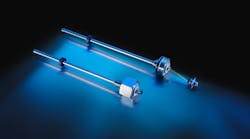Novotechnik TM1 Sensors Provide Highly Accurate Position Measurements
The TM1 Series magnetostrictive linear position sensors from Novotechnik U.S. feature a compact housing, aiding installation into hydraulic and pneumatic cylinders. The sensor is designed for integration inside or outside a cylinder which adds flexibility for engineers.
Features of the TM1 position sensors include:
- stroke lengths from 50-2,000 mm
- operating pressures up to 5,076 psi
- absolute linearity of ≤ 0.04% F.S.
- compliance with various EMC standards.
Accurate Measuring in Various Applications
Use of magnetostrictive technology for the TM1 sensors ensures a high level of accuracy for position measurements, achieving absolute linearity of ≤ 0.04% F.S. (min. 0.3 mm) and repeatability of ≤ ±0.1 mm.
Sensors are available in stroke lengths from 50-2,000 mm in 25 mm increments, offering options to suit a variety of application requirements. The sensors are capable of working in hydraulic or pneumatic cylinders with operating pressures up to 5,076 psi (350 bar) and peaks of 6,526 psi (450 bar), suiting use in a range of mobile, industrial and other high-pressure applications.
Novotechnik offers the sensors with various output options including voltage, current, CANopen and CAN SAE J1939, again providing engineers the ability to choose the appropriate solution which meets their specific requirements.
READ MORE - Sensors and Software in Motion Control: Key Benefits to Consider
Long-Lasting, Durably Designed Sensors
Novotechnik's TM1 Series sensors utilize touchless magnetostrictive technology which helps to provide a long lifespan for the sensors. This touchless design is achieved by affixing a magnetic ring-shaped marker to the moving hydraulic or pneumatic cylinder; the marker then moves up and down the sensor's shaft without contact, reducing the potential for wear and tear and thus a longer operational life.
Further design benefits include the sensors' compact housing. Not only does this aid their integration with hydraulic and pneumatic cylinders — as there is only so much mounting space to work with — but also applications with space constraints which is becoming a bigger concern in many machine designs. The sensors are also available in screw flange or plug-in flange models, making it easier for designers to choose the version which best meets their application requirements.
Both models are comprised of a stainless steel flange welded to a pressure-resistant rod. This helps to create a durable sensor design which can be used in harsh operating environments. All sensor models are sealed up to IP69K.
The sensors meet or exceed 11 EMC (electromagnetic compatibility) standards, including ISO, E1 and CISPR. This ensures their operation will not interfere with other electrical components and their own operation is secure from potential interference as well, further ensuring the sensors' durability in a variety of applications.
In addition, the sensors are shock and vibration protected to 100 and 20 g, respectively, and able to work in an operating temperature range of -40 to 105 C (-40 to 221 F).


